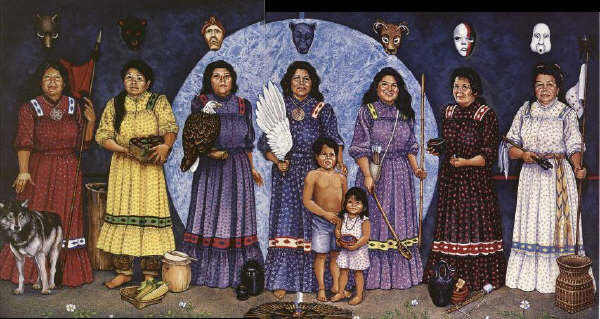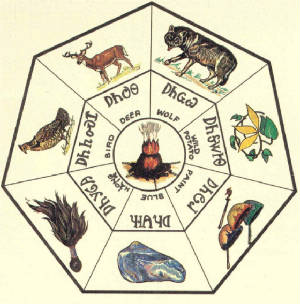|

|
Blue, or Panther, Clan (AniSahoni)
Also called the Wild Cat Clan. Named the Blue
Clan,
because of a blue medicine the clan made
from plants to keep
the children from becoming ill
Color: blue
Wood: ash. |
|
Long Hair Clan ( AniGilohi)
Also sometimes called the Twister, Hair hanging
down,
or Wind Clan. It's members
were teachers, keepers of traditions.
Gilahi is short for an ancient Gitlvgvnahita, the
Warrior Women's
society, meaning something that grows from the back of the neck".
Those belonging to this Clan wore their hair in elaborate
hairdos. The Peace Chief usually came from this Clan..
Color: Yellow Wood:
Beech |
|
Bird Clan ( AniTsisqua)
Keepers of the birds, sacred feathers, and bird
medicines.
Members of this Clan were the Messengers,
and were highly skilled at using blow guns and
snare traps.
Color: Purple
Wood: Maple |
|
Paint Clan ( Ani Wodi)
Makers of the red paint used in war.
Medicine Men, Wise Men
& Sorcerers came from this Clan
Color: White
Wood:Locust. |
|
Deer Clan (Ani Awi)
Keepers of the deer, or awi. The fastest
runners,
and best hunters. They were trackers, tanners,
and seamers,
and keepers of deer medicine.
Color: Brown
Wood: Oak |
|
Wild Potato Clan ( Ani Gatogewi)
Also called Bear, Racoon, or Blind Savannah Clan.
Makers of flour and bread from wild potatoes.
Members were
farmers, gatheres of the wild potatoes
(gatogewi meaning swamp)
Keepers and protectors of the earth.
Color: Green Wood:
Birch |
|
Wolf Clan (Ani Waya)
Keepers of the Wolf. Brave Warriors.
Protectors of the People.
The War Chief usually came
from this Clan
Color: Red
Wood: Hickory. |

Before the arrival of Europeans, our Society was entirely Matriarchal, which means
the descent was considered from the Mother's side of the family, unlike the European tradition of a woman joining a man's
family after marriage. The mother's family were, and still are in many places, the most important and powerful. A son would
receive most of his life training and direction from his mother's brother, not his father.
The wife owned the dwelling, and if a marriage was over, the man would return to
his family and leave the house and belongings with her, with the exception of what she allowed him to take.
Each person belongs to the Clan of thier mother. Marriage within a Clan is forbidden
even today. Marriage to another in the Clan of your father (paternal grandmother's clan) is also forbidden.
Each Clan took care of it's own elderly, widows and orphans. When visiting another
village, you were welcomed and taken care of by your own Clan. Each Clan was responsible for avenging wrongs and crimes against
it's members, many punishable by death.
Captives were often adopted by Clans. Once a Clan adopted a captive, they were responsible
for them as with all other Clan members. To outsiders, adoptees were often mistaken as being slaves.
Today, only a few of Our People can identify their Clan. If this information has
not been handed down through the generations, it is unlikely it can be found. There are few written records of Clan membership.
The Council House had seven sides, so that each clan's representatives could be seated in their own section.
Enter content here
|